A Modified Bird-Mating Optimization with Hill-Climbing for Connection Decisions of Transformers
Abstract
:1. Introduction
2. Problem Description
3. Proposed Approach
3.1. Bird-Mating Optimization
3.2. Hybrid Bird-Mating Optimization Approach
4. Computation of the Method
5. Numerical Studies
5.1. Case 1
5.2. Case 2
5.3. Case 3
5.4. Case 4
6. Conclusions
Acknowledgments
Author Contributions
Conflicts of Interest
References
- Chang, C.Y.; Yu, J.S.; Chen, C.S. Effects of Open-Wye/Open-Delta Transformers on the Operation of Distribution Systems. Electr. Power Syst. Res. 1986, 10, 167–174. [Google Scholar] [CrossRef]
- De Armas Teyra, M.A.; Gonzalez, G.G. Selection of Asymmetrical transformers banks with emphasis in losses and efficiency. IEEE Trans. Lat. Am. 2010, 8, 678–684. [Google Scholar] [CrossRef]
- Santoso, S.; Dugan, R.C. Experiences with the New Open-Wye/Open-Delta Transformer Test Cases for Distribution System Analysis. In Proceedings of the IEEE Power Engineering Society General Meeting, San Francisco, CA, USA, 16 June 2005; Volume 1, pp. 884–889.
- Tsay, M.T.; Chan, S.Y. Improvement in system unbalance and loss reduction of distribution feeders using transformer phase rearrangement and load diversity. Int. J. Electr. Power Energy Syst. 2003, 25, 395–401. [Google Scholar] [CrossRef]
- Chen, S.L.; Li, R.J.; Hsi, P.H. Traction system unbalance problem-analysis methodologies. IEEE Trans. Power Deliv. 2004, 19, 1877–1883. [Google Scholar] [CrossRef]
- Chua, K.H.; Lim, Y.S.; Taylor, P.; Morris, S.; Wong, J. Energy storage system for mitigating voltage imbalance on low-voltage networks with photovoltaic systems. IEEE Trans. Power Deliv. 2012, 27, 1783–1790. [Google Scholar] [CrossRef]
- Li, K.; Liu, J.; Wang, Z.; Wei, B. Strategies and operating point optimization of statcom control for voltage imbalance mitigation in three-phase three-wire systems. IEEE Trans. Power Deliv. 2007, 22, 413–422. [Google Scholar] [CrossRef]
- Lin, W.M.; Lu, K.H.; Ou, T.C. Design of a novel intelligent damping controller for unified power flow controller in power system connected offshore power applications. IET Gener. Transm. Distrib. 2015, 9, 1708–1717. [Google Scholar] [CrossRef]
- Shahnia, F.; Majumder, R.; Ghosh, A.; Ledwich, G.; Zare, F. Voltage imbalance analysis in residential low voltage distribution networks with rooftop PVs. Electr. Power Syst. Res. 2011, 81, 1805–1814. [Google Scholar]
- Ghahremani, E.; Kamwa, I. Optimal placement of multiple-type FACTS devices to maximize power system loadability using a generic graphical user interface. IEEE Trans. Power Syst. 2013, 28, 994–1000. [Google Scholar]
- Ghahremani, E.; Kamwa, I. Analysing the effects of different types of FACTS devices on the steady-state performance of the Hydro-Québec network. IET Gener. Transm. Distrib. 2014, 8, 233–249. [Google Scholar] [CrossRef]
- Lin, W.M.; Ou, T.C. Unbalanced distribution network fault analysis with hybrid compensation. IET Gener. Transm. Distrib. 2011, 5, 92–100. [Google Scholar] [CrossRef]
- Ou, T.C. A novel unsymmetrical faults analysis for microgrid distribution systems. Int. J. Electr. Power Energy Syst. 2012, 43, 1017–1024. [Google Scholar]
- Ou, T.C. Ground fault current analysis with a direct building algorithm for microgrid distribution. Int. J. Electr. Power Energy Syst. 2013, 53, 867–875. [Google Scholar]
- Zhu, J.; Bilbro, G.; Chow, M.Y. Phase balancing using simulated annealing. IEEE Trans. Power Syst. 1999, 14, 1508–1513. [Google Scholar]
- Zhu, J.; Chow, M.Y.; Zhang, F. Phase balancing using mixed-integer programming. IEEE Trans. Power Syst. 1998, 13, 1487–1492. [Google Scholar]
- Chen, T.H.; Cherng, J.T. Optimal phase arrangement of distribution transformers connected a primary feeder for system unbalance improvement and loss reduction using a genetic algorithm. IEEE Trans. Power Syst. 2000, 15, 994–1000. [Google Scholar] [CrossRef]
- Huang, M.Y.; Chen, C.S.; Lin, C.H.; Kang, M.S.; Chuang, H.J.; Huang, C.W. Three-phase balancing of distribution feeders using immune algorithm. IET Gener. Transm. Distrib. 2008, 714, 55–65. [Google Scholar] [CrossRef]
- Ding, F.; Loparo, K.A. Feeder reconfiguration for unbalanced distribution systems with distributed generation: a hierarchical decentralized approach. IEEE Trans. Power Syst. 2016, 31, 1633–1642. [Google Scholar] [CrossRef]
- Askarzadeh, A. Bird Mating optimizer: An optimization algorithm inspired by bird mating strategies. Commun. Nonlinear Sci. Numer. Simul. 2014, 19, 1213–1228. [Google Scholar] [CrossRef]
- Kersting, W.H. Distribution System Modeling and Analysis, 2nd ed.; CRC Press: Boca Raton, FL, USA, 2006. [Google Scholar]
- NEMA National Electrical Manufacturers Association. NEMA Standard MG1–1987: Motors and Generators; NEMA National Electrical Manufacturers Association: Arlington, VA, USA, 1987. [Google Scholar]
- TPC Taiwan Power Company. Technical Manual of Overhead Line Design for Distribution Systems; TPC Taiwan Power Company: Taipei, Taiwan, 2009. [Google Scholar]
- TPC Taiwan Power Company. Interconnection Guideline of Renewable Energy; TPC Taiwan Power Company: Taipei, Taiwan, 2009. [Google Scholar]
- Alajmi, B.N.; Ahmed, K.H.; Finney, S.J.; Williams, B.W. Fuzzy-logic-control approach of a modified hill-climbing method for maximum power point in microgrid standalone photovoltaic system. IEEE Trans. Power Electr. 2011, 26, 1022–1030. [Google Scholar] [CrossRef]
- Haupt, R.L.; Haupt, S.E. Practical Genetic Algorithms, 2nd ed.; Wiley: Hoboken, NJ, USA, 2004. [Google Scholar]
- Clerc, M. Particle Swarm Optimization; Wiley: Hoboken, NJ, USA, 2010. [Google Scholar]
- Ou, T.C.; Chuang, S.J.; Hong, C.M.; Wu, R.C.; Tsao, T.P.; Chen, C.Y. Self-regulation ground faults model for microgrid distribution. ICIC Express Lett. Part B Appl. 2015, 6, 3225–3230. [Google Scholar]
- Ou, T.C.; Hong, C.M. Dynamic operation and control of microgrid hybrid power systems. Energy 2014, 66, 314–323. [Google Scholar] [CrossRef]
- Hong, C.M.; Ou, T.C.; Lu, K.H. Development of intelligent MPPT (maximum power point tracking) control for a grid-connected hybrid power generation system. Energy 2013, 50, 270–279. [Google Scholar] [CrossRef]
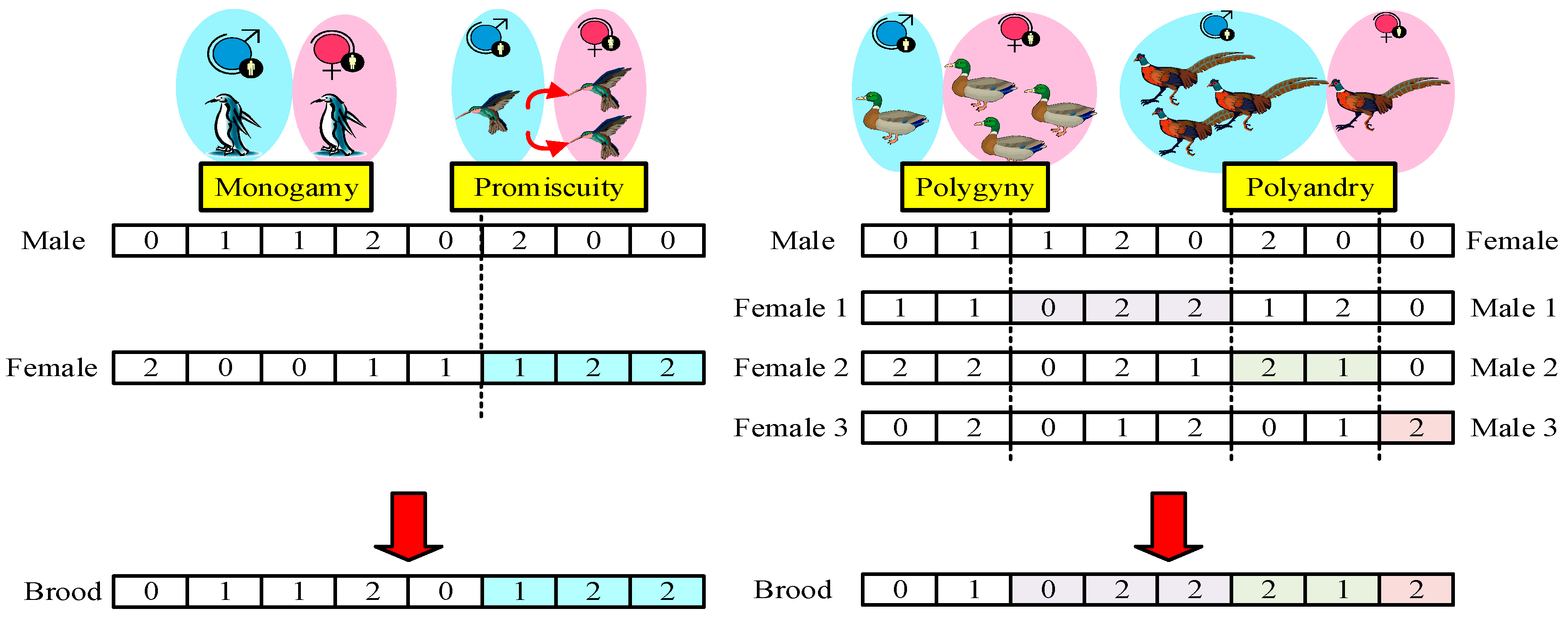

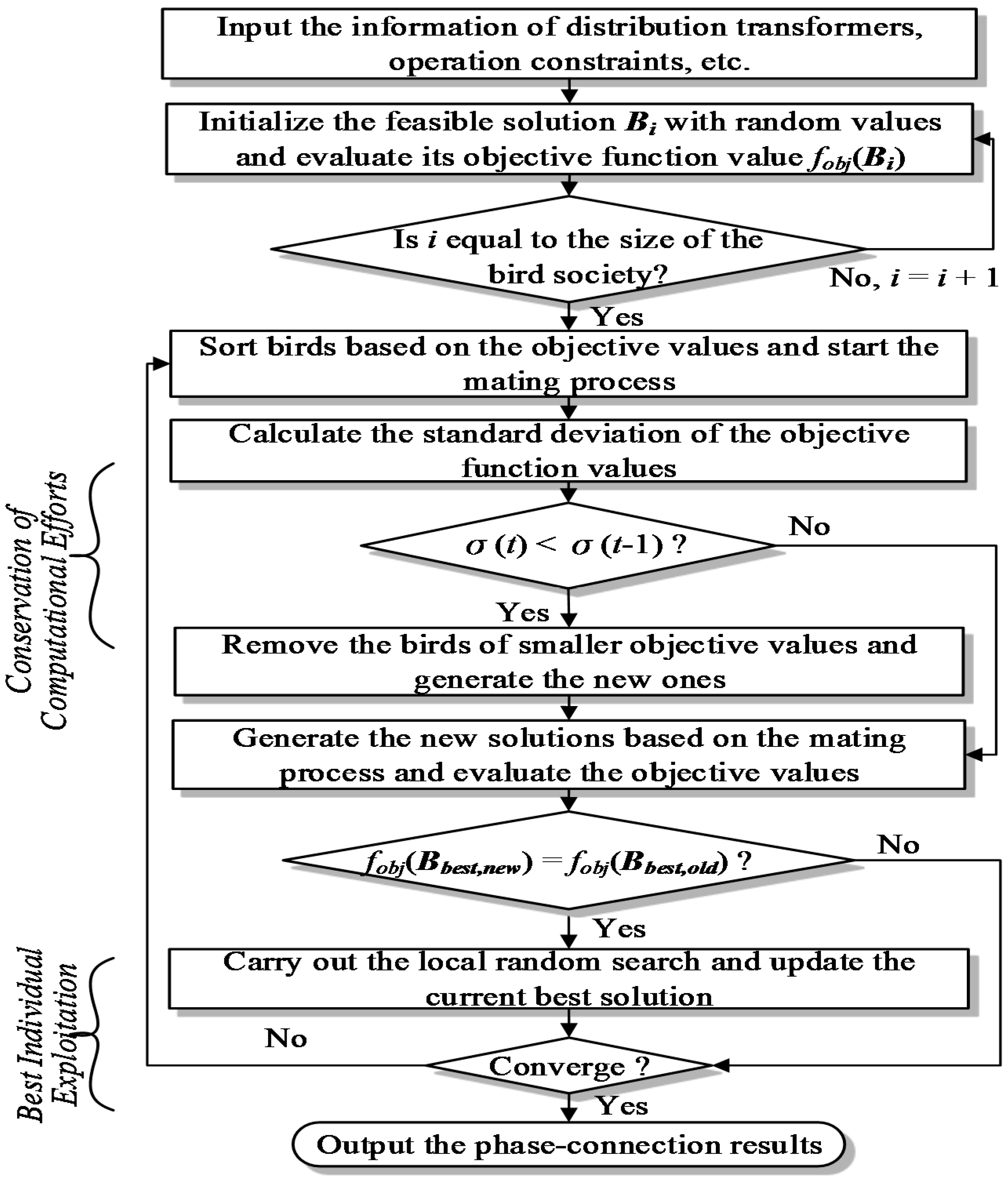

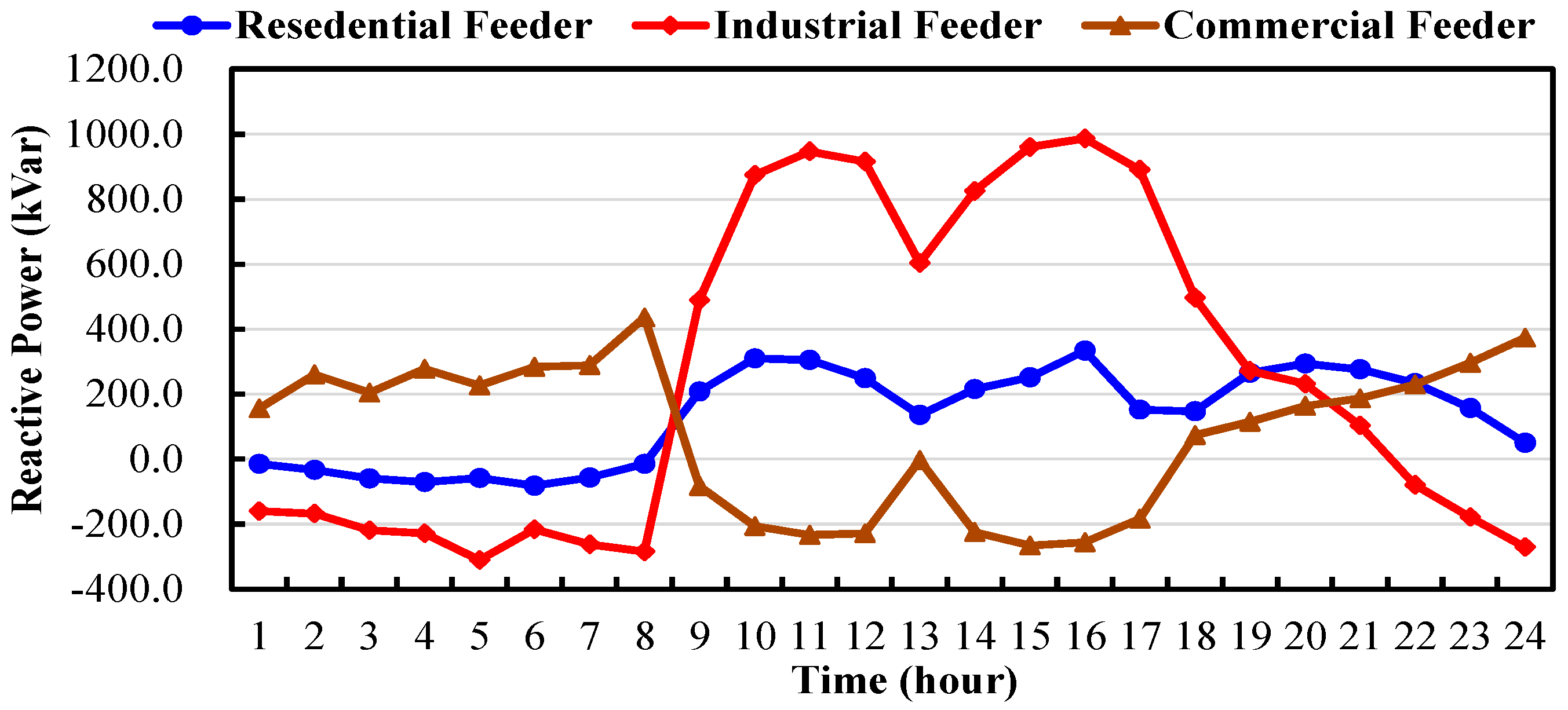

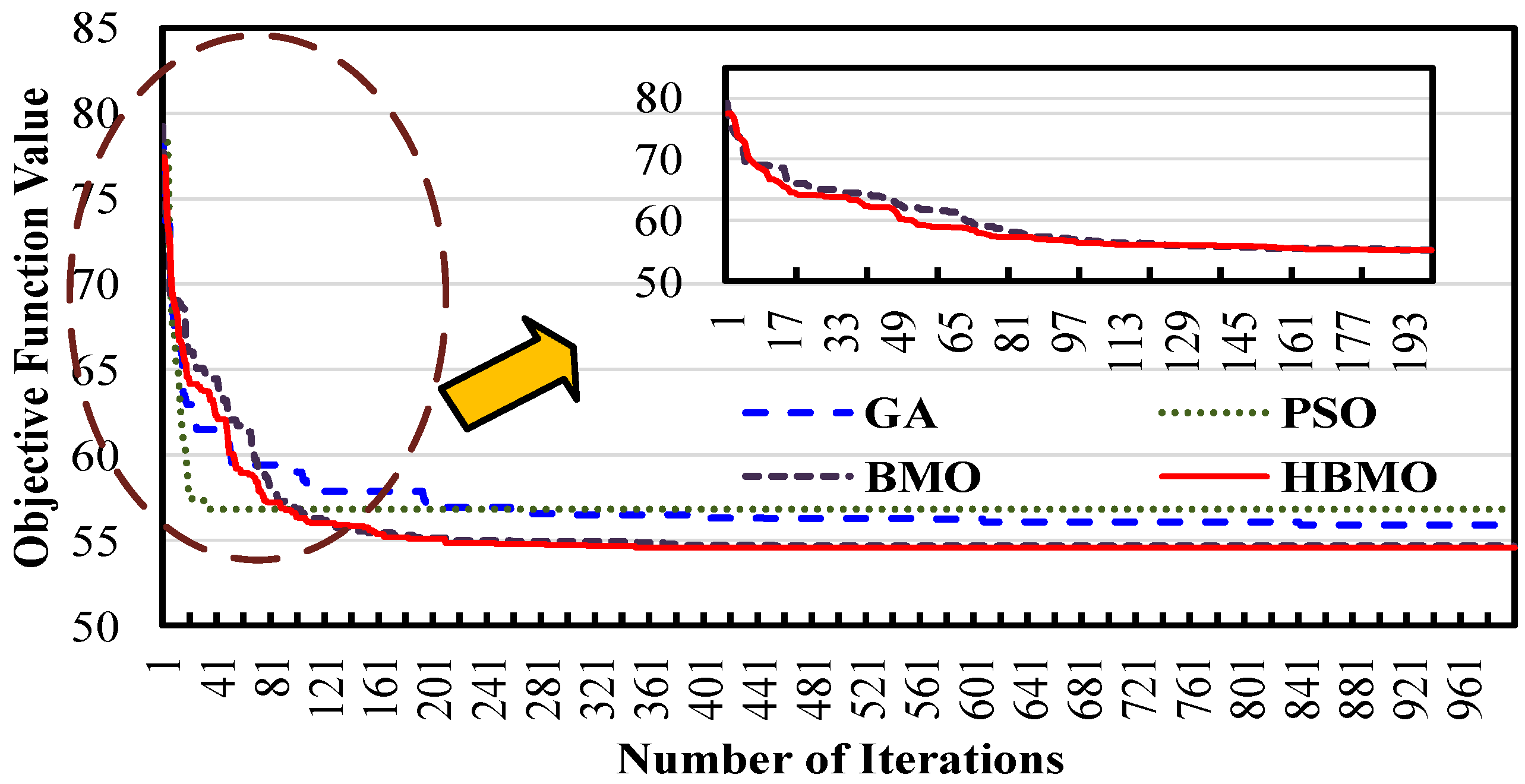

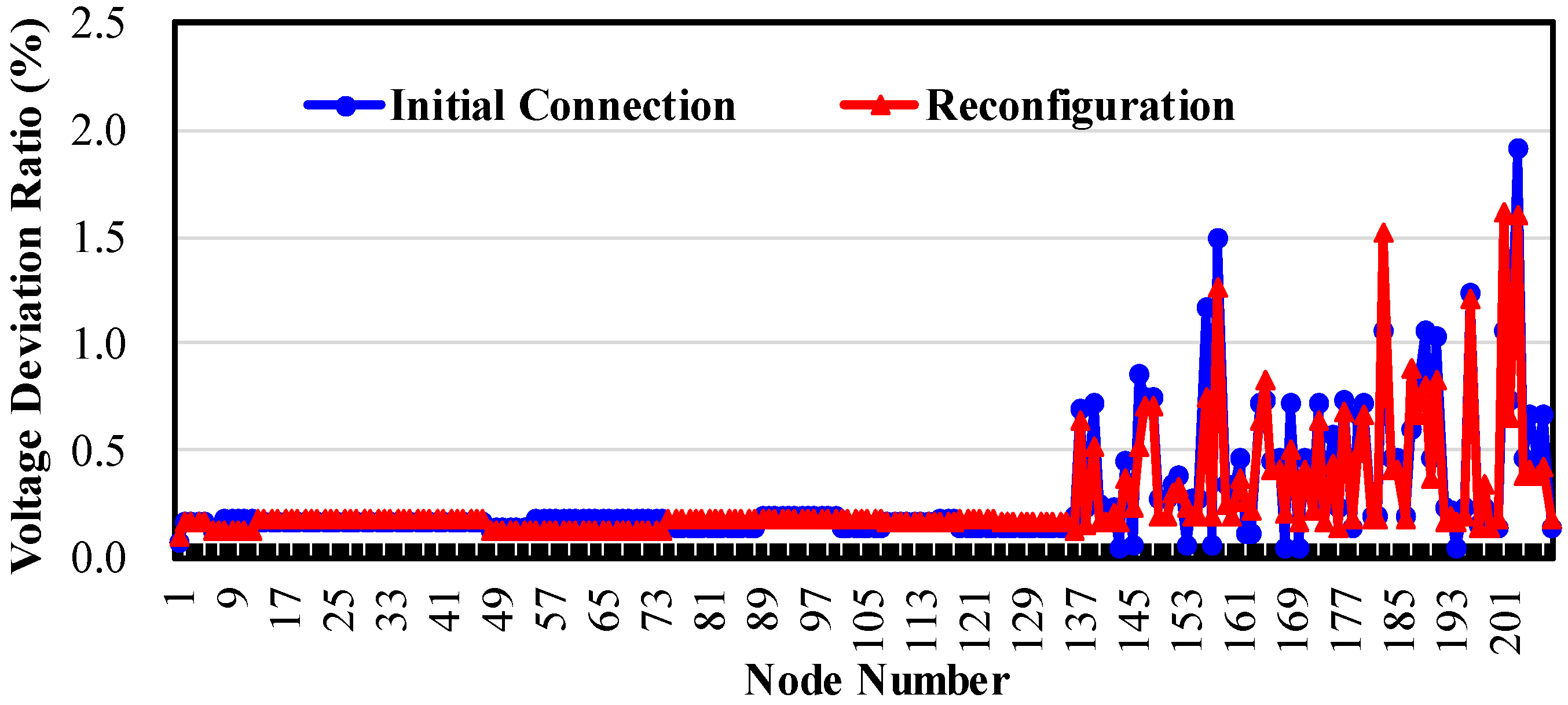


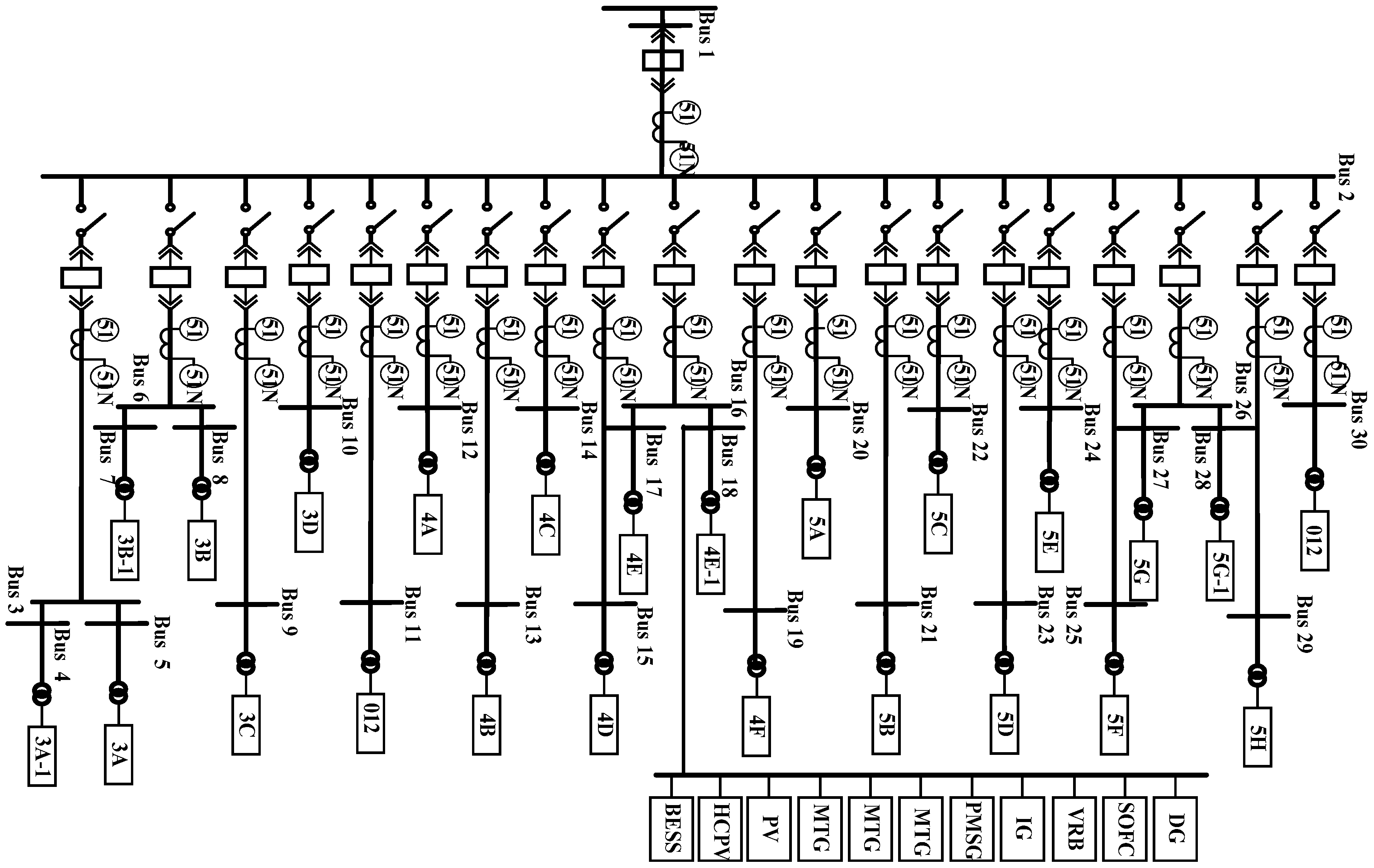
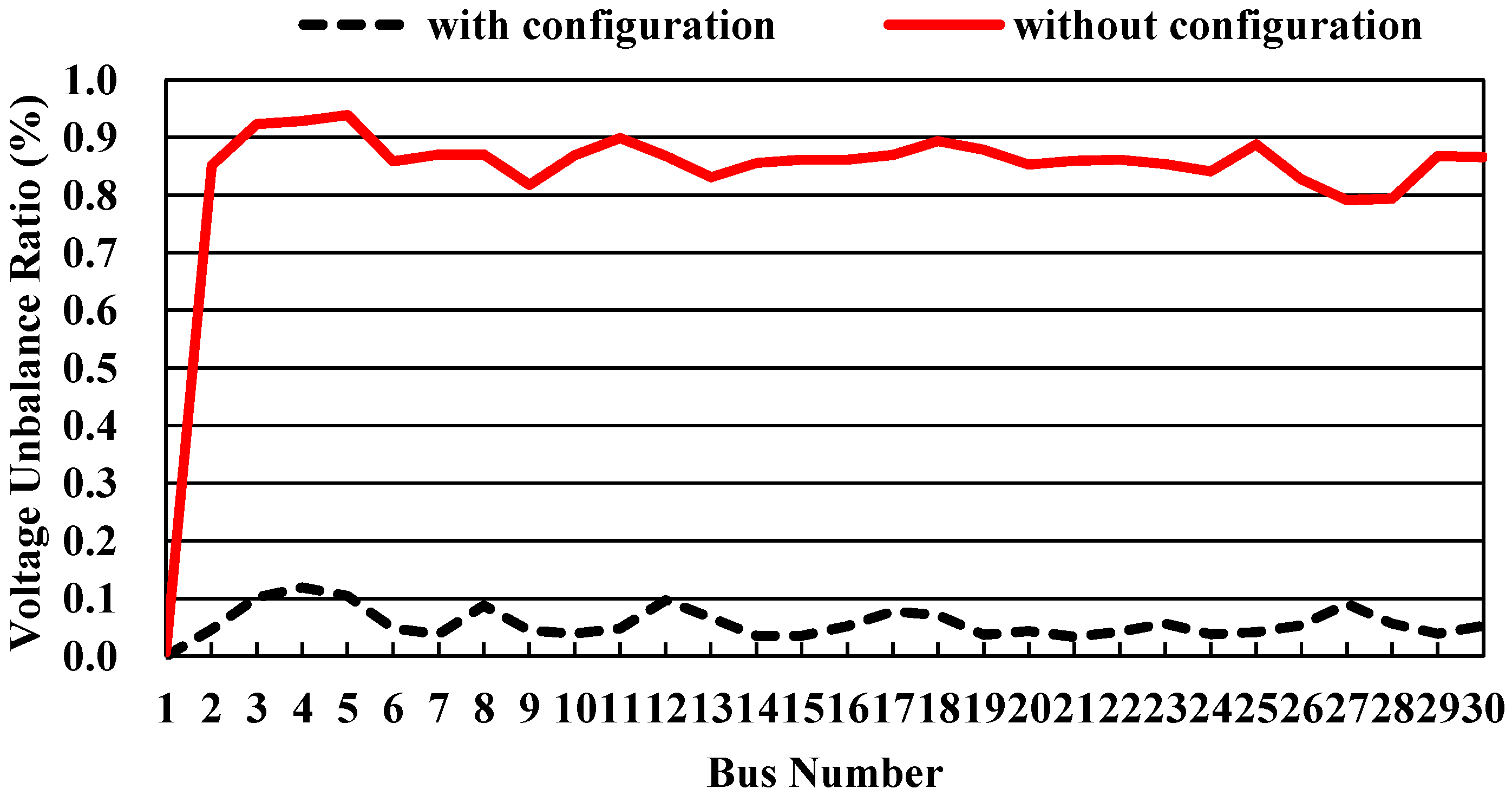

| Max. VUR% | GA | PSO | BMO | HBMO |
|---|---|---|---|---|
| Origin | 1.74% | 1.74% | 1.74% | 1.74% |
| Result | 1.16% | 1.16% | 1.14% | 1.14% |
© 2016 by the authors; licensee MDPI, Basel, Switzerland. This article is an open access article distributed under the terms and conditions of the Creative Commons Attribution (CC-BY) license (http://creativecommons.org/licenses/by/4.0/).
Share and Cite
Ou, T.-C.; Su, W.-F.; Liu, X.-Z.; Huang, S.-J.; Tai, T.-Y. A Modified Bird-Mating Optimization with Hill-Climbing for Connection Decisions of Transformers. Energies 2016, 9, 671. https://doi.org/10.3390/en9090671
Ou T-C, Su W-F, Liu X-Z, Huang S-J, Tai T-Y. A Modified Bird-Mating Optimization with Hill-Climbing for Connection Decisions of Transformers. Energies. 2016; 9(9):671. https://doi.org/10.3390/en9090671
Chicago/Turabian StyleOu, Ting-Chia, Wei-Fu Su, Xian-Zong Liu, Shyh-Jier Huang, and Te-Yu Tai. 2016. "A Modified Bird-Mating Optimization with Hill-Climbing for Connection Decisions of Transformers" Energies 9, no. 9: 671. https://doi.org/10.3390/en9090671
APA StyleOu, T.-C., Su, W.-F., Liu, X.-Z., Huang, S.-J., & Tai, T.-Y. (2016). A Modified Bird-Mating Optimization with Hill-Climbing for Connection Decisions of Transformers. Energies, 9(9), 671. https://doi.org/10.3390/en9090671








